 It is the final project for UIUC IS 597 pr. Created by Xinmai Xuan (xinmaix2).
It is the final project for UIUC IS 597 pr. Created by Xinmai Xuan (xinmaix2).
To run the simulation, please run the python file "Catan_basic.py" file. All visualization results would stored in folder './data/output' folder. All border would store in folder './data/border'
- Put repeated function into
Universal_func.pyfile - Change visualization of compete version
- Edit doctest and document for better understanding
- Still have some bugs for Harbor_prefer strategy. It may reach the largest round set (400 in default) when deployed with city-prefer player.
- Add compete code for current version
- Modify compete part code
- integrated functions into separate py files
- Added Catan_basic_compete part designed to put players with different strategy into same board instead of different board. To run this code, please run file Catan_basic_Compete.py file
- Small flaws for harbor prefer strategy in compete file. Might be failed to reach required vp point in hypothesis 2.
Catan, formerly known as Settlers of Catan, is a strategic board game designed by Klaus Teuber and first published in 1995. The game is set on an island called Catan, where players take on the roles of settlers trying to build and develop their settlements by acquiring and trading resources. The base game is played on a modular board consisting of hexagonal tiles representing five different resources: brick, wood, sheep, wheat, and ore, along with a desert tile that produces no resources. In addition, there are number tokens and harbors placed on the board, which play a role in resource production and trading.
- Setup: Randomly arrange the resource tiles and number tokens to form the island. Each player places two settlements and two roads on the board.
- Turn order: Players take turns clockwise, starting with the first player.
- Turn structure: On a player's turn, they perform the following actions in order: a. Roll dice: The player rolls two six-sided dice to determine which tiles produce resources. Tiles with number tokens matching the sum of the dice generate resources for adjacent settlements and cities. b. Trade: Players can trade resources with each other or with the bank, using a 4:1 ratio or a more favorable rate if they have a settlement/city adjacent to a harbor. c. Build: Players can spend resources to build roads, settlements, or cities, or to buy development cards. Settlements must be at least two roads apart, and roads must connect to existing settlements/cities/roads.
- Points: Players earn victory points for building settlements (1 point), cities (2 points), and acquiring certain development cards (1 point). The first player to reach 10 victory points wins the game.
- The Robber: If a player rolls a 7, they must move the robber to any resource tile other than its current location, and that tile will not produce resources until the robber is moved again. Additionally, players with more than 7 resource cards must discard half of them (rounded down) when a 7 is rolled.
- Development Cards: These cards can provide players with various benefits, such as resources, victory points, or the ability to move the robber.
- Longest Road and Longest Army (Not in this simulation): Players can earn bonus points by having the longest continuous road (2 points) or the largest army through the use of Knight cards (2 points). These titles can change hands throughout the game.
The game board is consisted by 19 different terrains. Each terrain owns a specific number and a generated resource. Player would get the resource the time they build a settlement or a cicy besides the terrain which owns the same number as the results of dice rolls.
- resource type
There are six different resources:
- Hills: Resources number 1, Produce Brick, 3 in total
- Forest: Resources number 2, Produce Lumber, 4 in total
- Mountains: Resources number 3, Produce Ore, 3 in total
- Fields: Resources number 4, Produce Grain, 4 in total
- Pasture: Resources number 5, Produce Wool, 4 in total
- Desert: Resources number 0 Produce Nothing, 1 in total
- Number Each terrain, except Desert, has a special points between 2 and 14, except 7.
- Harbor
Some terrains located on the edge of the board may have harbors. There are 2 main types of harbors: Generic Harbor and Special Harbor.
Player could exchange 3 identical resources for any 1 other resource during trade phase if owns a generic Harbor.
Player could exchange 2 designated resources for any 1 other resource during trade phase if owns a special Harbor, based on they type of special harbor.
- There are 4 generic harbors and 5 special harbors.
- generic harbor: Harbor number 6
- special hill: number 1
- special forest: number 2
- special mountains: number 3
- special fields: number 4
- special pasture: number 5
- There are 4 generic harbors and 5 special harbors.
- Point The point of the corner of each terrain. Each terrain has 6 points. Player could build settlement or upgrade a settlement on some point they could use.
There are 4 building options in Catan, however, we only use 3 types in this model
- Road Cost: 1 lumber and 1 brick Road connects two points. Settlement can only be build on points that connected by roads.
- Settlement Cost: 1 brick, 1 lumber, 1 grain, 1 wool Each settlement could gain 1 resource if possible. Settlement can not build on 2 neighbor points.
- City Cost: 2 grain, 3 ore City can only be upgraded from settlement. Each city could gain 2 resource if possible.
- Development Card Not included in this experiment.
- Point
class Point:
def __init__(self, idx):
self.idx = 0
self.neighbors = []- Terrain
class Terrain:
def __init__(self, resource, num, point_li):
self.resource = resource
self.num = num
self.point = point_li- Player
class Player:
def __init__(self):
self.vp = 0 # victory points
self.reachable_points = [] # points connected via roads
self.settlements = []
self.cities = []
self.resources_list = [0, 0, 0, 0, 0]
self.road_num = 0
self.strategy = ""- ResourceDict
class ResourceDict:
def __init__(self, resource_type: str):
self.needed_dict = {0: 1, 1: 1} if resource_type == "road" else {0: 1, 1: 1, 3: 1, 4: 1} if \
resource_type == "settlement" else {2: 3, 3: 2}
self.resource_list = [2, 3, 4] if resource_type == "road" else [2] if \
resource_type == "settlement" else [0, 1, 4]
self.target_list = [0, 1] if resource_type == "road" else [0, 1, 3, 4] if \
resource_type == "settlement" else [2, 3]- RecordList
class RecordList:
def __init__(self, vp_rec, set_rec, city_rec, road_rec, brick_rec, lum_rec, ore_rec, grain_rec, wool_rec):
self.vp_rec = vp_rec
self.set_rec = set_rec
self.city_rec = city_rec
self.road_rec = road_rec
self.brick_rec = brick_rec
self.lum_rec = lum_rec
self.ore_rec = ore_rec
self.grain_rec = grain_rec
self.wool_rec = wool_rec- RecordList
class ResRecoder:
def __init__(self, used_round, gamePass):
self.used_round = used_round
self.gamePass = gamePass- Though we compare player with different strategy, they will not compete with each other. All players have a private border.
- Though player still need to discard resources if they roll 7, no terrain were detained by robber. Robber will only stay in dessert.
- All harbor in this simulation are universal harbors(3 : 1).
- All players in this simulation would not change their strategy until end of game.
- We do not have development card in this simulation. Besides, the longest road and the longest army would not implement in this simulation.
Due to the real game rules and workload consideration, I listed all possible random variables that might be used in this final project. Random Variables 1: The number of points obtained by rolling two dice. It should be simulated as triangular. Random Variables 2: The resource distribution of each resource’s bricks. Random Variables 3: The chance of earning resource of each resource’s bricks(Number for each terrain).
- Number of Two Dice
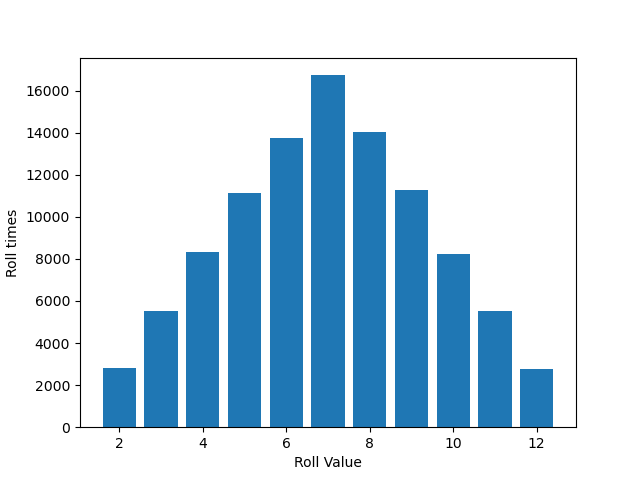
- Border Generator
Border for each simulation could be found in file
data\border\folder
- The number of rolling 2 dices will conform triangle distribution between [2, 12]
- Player would only choose the point has the highest probability as the default point
- Player would only build roads to the neighbor point has the highest probability unless on harbor prefer action
We simulate 1000 times for each hypothesis. Everytime a simulation ends, the used round timer would output and stored in a list. Each hypothesis would output 2 list stores all round for two different situations. Each simulation would use a new board.
Assume upgrading a city can help get the required vp points faster than case 2 building a new settlement.
The hypothesis compares two strategy: upgrading a city prefer and build a new settlement prefer. From the output, the resulting average used rounds of settlement prefer is 124.916, the resulting average used rounds of city prefer is 93.127.
From the histogram, we can see that it is more rewarding to adopt city prefer methods rather than settlement.
Thus, this hypothesis is valid.
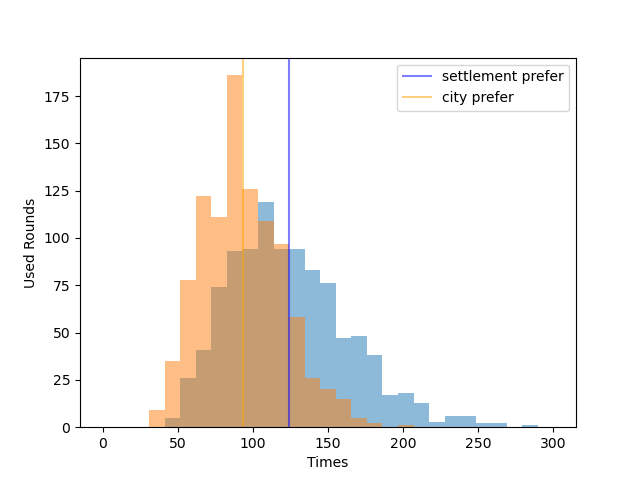 Below is the compare for two different strategy on the same board. The number represents the number if player use this strategy reaches required point faster. Though settlement_prefer strategy wins at some time, city_prefer strategy player wins most of the time.
Below is the compare for two different strategy on the same board. The number represents the number if player use this strategy reaches required point faster. Though settlement_prefer strategy wins at some time, city_prefer strategy player wins most of the time.
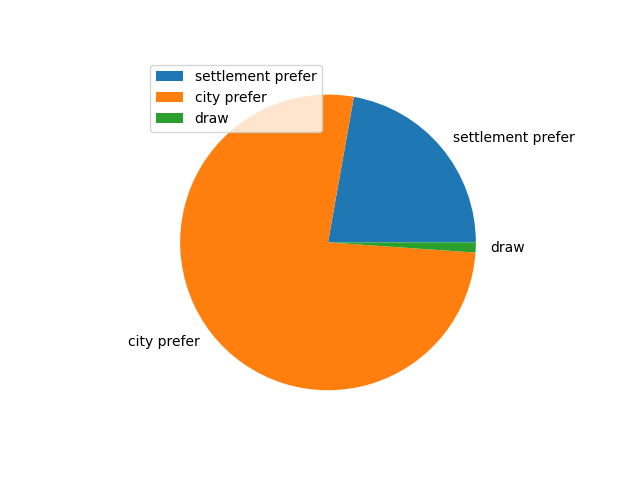
Assume getting a particular port can help get the required vp points faster than upgrading a ctiy which could help get more resources.
The hypothesis compares two strategy: upgrading a city prefer and build a new settlement prefer. From the output, the resulting average used rounds of harbor prefer is 106.492, the resulting average used rounds of city prefer is 93.127.
From the histogram, we can see that it is more rewarding to adopt city prefer methods rather than settlement.
Thus, this hypothesis is valid.
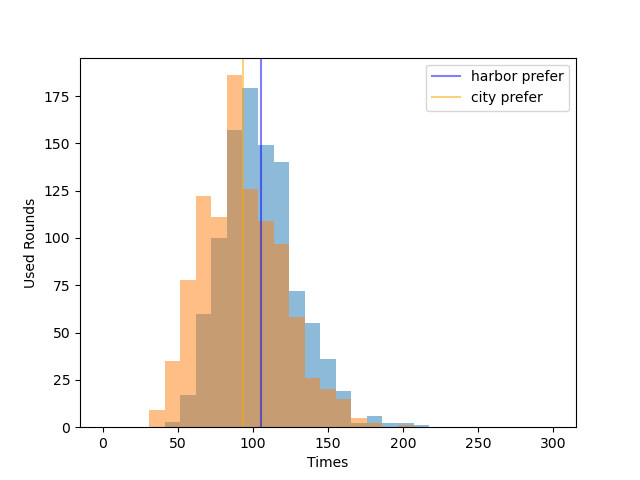 Below is the compare for two different strategy on the same board. The number represents the number if player use this strategy reaches required point faster. Though harbor_prefer strategy wins at some time, city_prefer strategy player wins most of the time.
Below is the compare for two different strategy on the same board. The number represents the number if player use this strategy reaches required point faster. Though harbor_prefer strategy wins at some time, city_prefer strategy player wins most of the time.
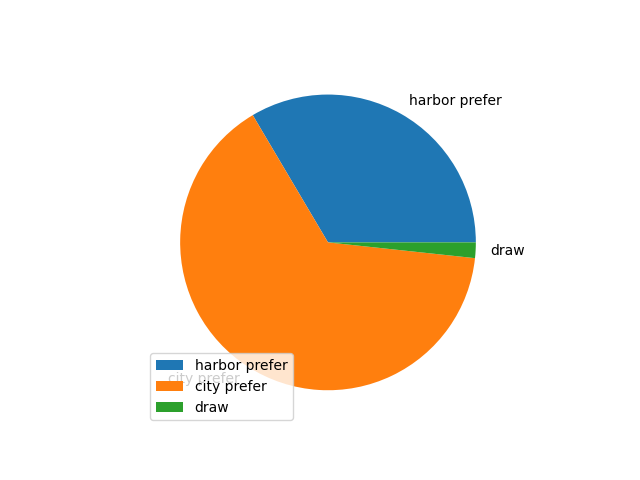
Assume upgrading a city can help get the required vp points faster than case 2 building a new settlement.
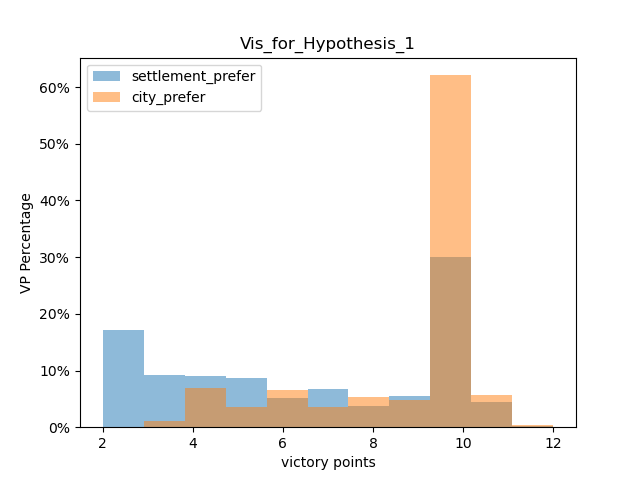
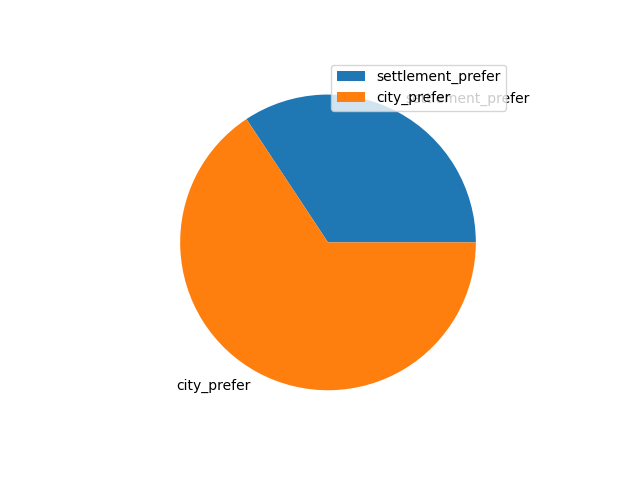
Assume getting a particular port can help get the required vp points faster than upgrading a ctiy which could help get more resources.
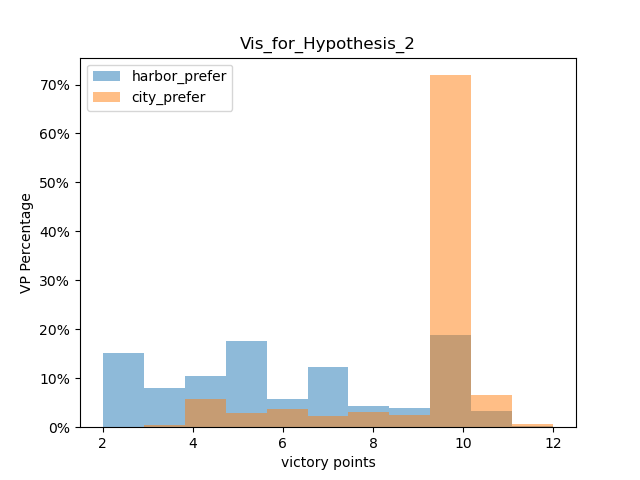

- Unlike un compete version, player would play in a same board based on their strategy, each simulation would stop immediately when a player reaches the required point
- I create different visualization plot for compete version. Pie plot is the same, wherever the bar plot shows the distribution for each strategy if they failed to win their game
- Catan Photo: Catan Universe - Changelog 2.3.2 - Steam News. 19 Apr. 2023, store.steampowered.com/news/app/544730/view/5978007465995605824?l=english.
- Catan Introduction Wiki: Catan. “Catan.” Wikipedia, 11 Apr. 2023, en.wikipedia.org/wiki/Catan.
- Catan rules: “Game Rules.” CATAN, www.catan.com/understand-catan/game-rules.
- BFS Tree Idea: Wikipedia contributors. “Breadth-first Search.” Wikipedia, 27 Feb. 2023, en.wikipedia.org/wiki/Breadth-first_search.